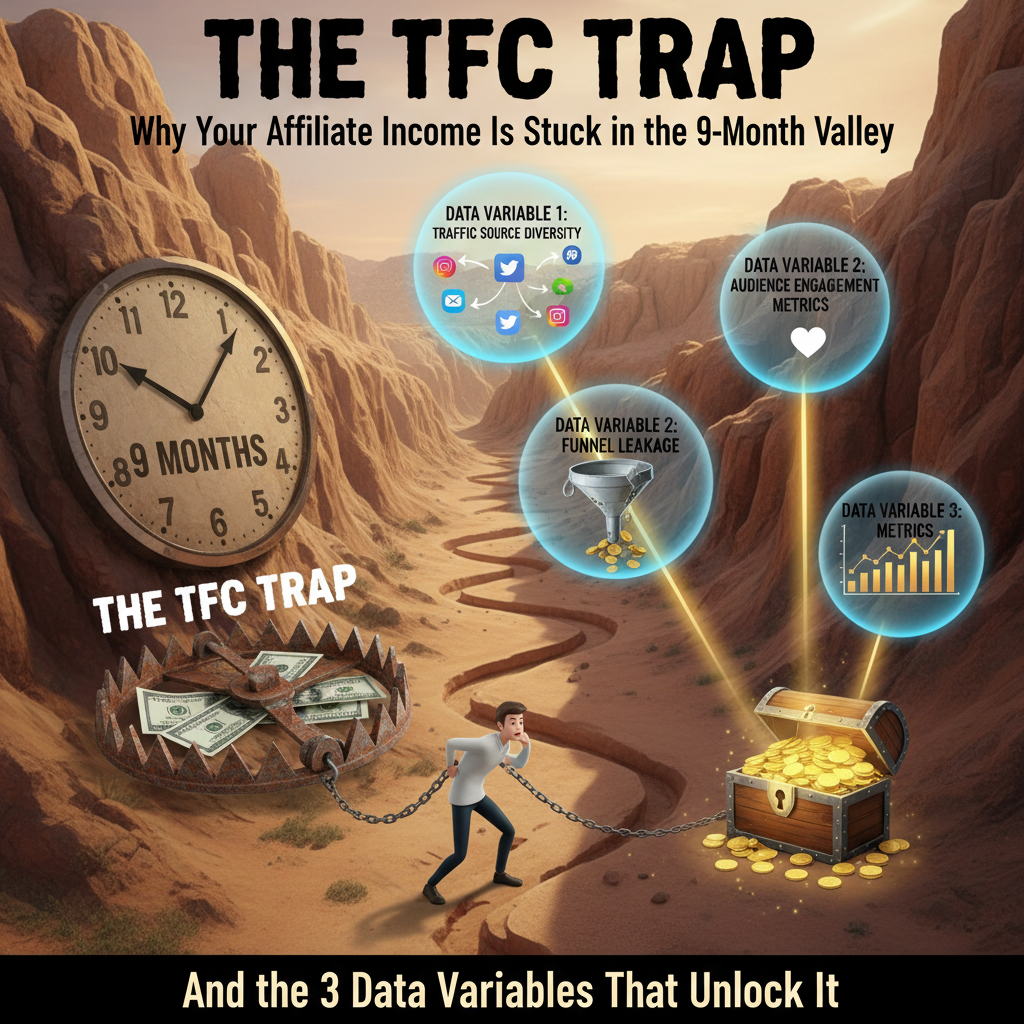Stuck in the TFC Trap? Learn the 3 data variables—Contextual Mapping & Intent Gaps—that Google demands to unlock affiliate revenue. Essential

Post by Peter Hanley coachhanley.com
The TFC Trap: Why Your Affiliate Income Is Stuck in the 9-Month Valley (And the 3 Data Variables That Unlock It)
If you’ve invested hundreds of hours, published dozens of articles, and feel like you’re perpetually stuck in a low-revenue holding pattern, you are not failing. You are simply caught in the TFC Trap.
The Time-to-First-Conversion (TFC) is the cruel period where your effort vastly outweighs your results. It’s the moment most affiliates quit. They blame the market, the niche, or the products, but the real issue is purely technical: you’re missing the 3 proprietary data variables that Google and your customers demand before releasing the revenue floodgates.
The problem isn’t about writing more content; it’s about architecting authority. Modern search engines—fueled by BERT and RankBrain—don’t reward volume; they reward systemic topical coverage and predictive user engagement.
This article is your diagnostic tool. We will deconstruct the psychological and algorithmic barriers keeping your traffic from converting, revealing the exact infrastructure changes you must implement now to force your breakthrough and escape the dreaded 9-Month Valley forever. It’s time to stop editing fragments and secure your future income.
Decoding the Time-to-First-Conversion (TFC) Loop
The TFC Trap is a predictable, three-stage delay rooted in algorithmic caution and human skepticism. If you are past the 90-day mark without consistent, scalable affiliate conversions, you are running into one of two fundamental failures: The Contextual Mapping Delay or The Conversational Intent Gap.
The Emotional Cost of the ‘Three-Month Dropout’
The Three-Month Dropout is the psychological barrier that precedes the technical one. Marketers quit not because the strategy is bad, but because the effort-to-reward ratio becomes intolerable. You need immediate validation that your work is building a scalable asset, even before the big payouts arrive.
Understanding the TFC Loop gives you that validation. It confirms that the delay is not personal; it is a feature of how modern search engines establish E-E-A-T (Experience, Expertise, Authoritativeness, and Trust). Google has to prove you are a legitimate source before they trust you with commercial queries. Your mission is to accelerate this proof.
How to accellerate seo and get people to read your stuff
TFC vs. Time-to-Scale: Defining Your Affiliate Timelines
Don’t confuse your first small sale (TFC) with true scale.
- TFC (Time-to-First-Conversion): Can be as short as 30–60 days with perfect execution. It’s the proof-of-concept.
- Time-to-Scale: The moment your system consistently generates 4-5 figure monthly income. This happens only after you’ve successfully closed the 3 Data Variables, typically occurring between the 6- and 9-month marks.
Your singular focus right now must be mastering the variables that shorten the TFC and demand the algorithms recognize your authority.
Variable 1: The Contextual Mapping Delay (BERT Optimization)
The first major barrier is purely algorithmic: Google does not yet understand the full context of your website. This is the Contextual Mapping Delay. If your articles feel isolated and unconnected, Google’s BERT model cannot confidently map your site as an authority entity on your subject, resulting in poor rankings for your highest-value commercial keywords.
To fix this, you must think like an SEO content architect and mandate that the search engine sees your site as a singular, comprehensive knowledge base.
Entity Saturation: Are You Covering the Full Topic Graph?
Most affiliates publish one article per keyword. True experts publish an entire topical cluster. Entity Saturation means covering the core topic (the pillar post) and all 5-10 related sub-topics (the cluster articles) simultaneously.
If you write about “best email marketing tools,” you must also cover “email open rates,” “A/B testing subject lines,” and “email deliverability.” If you leave gaps in this Topic Graph, Google will send traffic to a site that demonstrates deeper, more comprehensive expertise. Your actionable step is to audit your site and close every single entity gap with supporting content.
Anchor-Text-to-Intent Mismatch: Why Your Links Fail to Pass Authority
Internal linking is not just for user navigation; it is how you programmatically pass Link Equity and establish your Authority Graph. The TFC Trap is often set by weak, generic internal links.
- The Problem: Your link text (the anchor text) often says “click here” or “read more.” This tells Google nothing about the destination page’s core topic.
- The Fix: You must use descriptive, high-intent anchor text that maps directly to the target page’s entity. For example, use “our definitive guide to Brand Voice Guardrails” instead of “click here.” Secure your site’s hierarchy by making every link a definitive signal of topical relevance.
Internal Linking Prompts: Architecting Your Authority Graph
Your goal is to build a visible Authority Graph where every cluster article links to the pillar post, and the pillar post links to every cluster article. This structure forces Google to associate every piece of content with the main seed topic.
Execute this plan: When you create a new cluster piece, ensure it contains 3–5 embedded links using varied, descriptive anchor text pointing to the Pillar. This guarantees that topical depth is instantly registered by the algorithms, accelerating your ranking trajectory and demanding the full E-E-A-T score.
Variable 2: The Conversational Intent Gap (RankBrain Dynamics)
The second TFC barrier is behavioral. RankBrain and other engagement signals look at how users interact with your content to determine its ultimate quality. If users land on your page but immediately bounce, you have a Conversational Intent Gap—your content isn’t satisfying the deep, subconscious need behind the search query.
This is the point where you demand a commitment from the visitor.
The Zero-Click Problem: How to Use FAQs to Capture Featured Snippets
Most informational queries result in a Zero-Click search result, meaning the user finds their answer directly on the Google SERP (in a Featured Snippet or AI Summary). This is a deathblow to traffic.
To dominate this layer, you must structure your content to be instantly extractable, but also compelling enough to require a click.
- The Fix: End every major section with an FAQ Reinforcement Loop. Use clear, concise Q&A pairings that answer the conversational intent of the long-tail query. Format these answers in scannable, direct language (short lists, numbered steps) that is perfect for Featured Snippet extraction. Crucially, the answer must tease the solution and require the user to click the article to get the full implementation details. Convert the zero-click into a guaranteed click.
Micro-Commitment CTAs: Engineering the Path to a Click
A conversion is not a single event; it’s a series of Micro-Commitments. The biggest TFC delay comes from waiting until the end of the article to ask for the sale.
You need to use a Transactional Bridge throughout the content:
- Transactional Language: Integrate verbs like Unlock, Implement, Demand, Force, Secure, Activate directly into your subheadings and body copy.
- Mid-Article CTAs: Embed small, friction-free Micro-Commitment CTAs halfway through the article. These should drive email sign-ups or internal consumption. Each commitment moves the reader closer to the final transaction. Don’t wait; secure the conversion early.
The Dwell-Time Algorithm: Using Open/Close Loops to Simulate Expert Cognition
Dwell Time (the time a user spends on your page before returning to the SERP) is one of the most powerful RankBrain signals. If a user spends 8 minutes on your 10-minute read, Google registers extreme satisfaction.
To achieve maximum Dwell Time, your writing must simulate the structure of expert human thought using Open/Close Tension:
- Open: State a problem or ask a challenging question at the start of a paragraph. (e.g., “But how do you ensure the AI doesn’t forget your brand voice?”)
- Close: Answer the question concisely, but then immediately open a new, related curiosity loop to transition to the next paragraph. (e.g., “…The secret lies in the Centralized Knowledge Base. But what should that base contain to be truly effective?”)
This narrative strategy is an algorithmic magnet, forcing the reader to continue engaging until they reach the final, transactional Call-to-Action. Demand their focus from start to finish.
The TFC Escape Plan: Your 90-Day Acceleration Blueprint
The only way to escape the 9-Month Valley is through immediate, systematic implementation. This is your 90-day execution roadmap. Do not delay—your income depends on this structure.
Phase 1 (Days 1–30): The Guardrail Setup and Semantic Mapping
Your initial 30 days are purely architectural. You are fixing the core Contextual Mapping Delay.
- Define Authority: Create your Brand Voice Guardrails (Core Persona, Stylistic Non-Negotiables) and embed them into your content generation workflow.
- Audit & Map: Identify your primary Pillar Topic and all required supporting Cluster Entities.
- Execute Saturation: Publish the Pillar content and at least three Cluster articles, using descriptive Anchor Text to link them all together immediately. This instantly signals topical authority to BERT. Secure your entity map now.
Phase 2 (Days 31–60): Conversion Bridge Injection and Testing
The second phase injects transactional power and fixes the Conversational Intent Gap.
- Zero-Click Attack: Audit your top 10 informational pages and inject FAQ Reinforcement Loops to target high-value Featured Snippets.
- Micro-Commitment Integration: Embed 3–5 Micro-Commitment CTAs throughout the middle of your Pillar and high-traffic Cluster articles. These should drive email sign-ups or internal consumption.
- Language Refinement: Use the Transactional Verbs and Open/Close Tension framework on all new content. Demand engagement.
If this is too demanding you can always get it all done for you by Joining Michael Cheney’s apprentice group
Phase 3 (Days 61–90): Feedback Loop Preparation and Final Scaling
The final phase prepares for true, automated scale by prioritizing data flow.
- Data Structuring: Begin tracking which specific CTA language and Headline angles lead to the highest Click-Through Rates and Dwell Times.
- System Integration: Prepare the infrastructure to connect this winning data back into your content creation process (your Seamless Data Feedback Loop).
- Scale: With the Authority Deficit solved and the Conversational Intent Gap closed, you are now ready to publish the remaining Cluster content and begin scaling your output based on performance data. Your consistent income starts now.
You are no longer a struggling affiliate; you are an SEO architect. The TFC Trap is only powerful if you remain passive. By mastering these 3 Data Variables—Contextual Mapping, Conversational Intent, and Systematic Implementation—you not only escape the 9-Month Valley but force the algorithmic recognition required for predictable, exponential income.
Implement this 90-day plan immediately. Your authority waits.
This blog was written on a foundation by Wealthy Affiliate , Logo and images by Wealthy affiliate and reseach and writing support by Google Gemini
